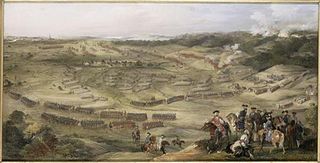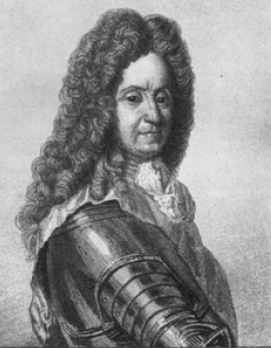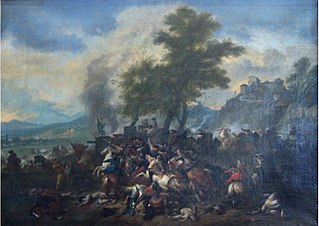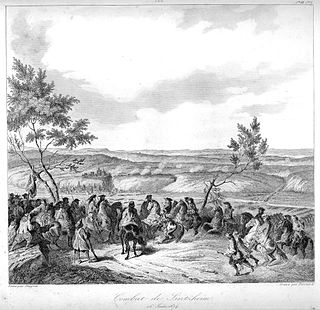
The Battle of Blenheim fought on 13 August [O.S. 2 August] 1704, was a major battle of the War of the Spanish Succession. The overwhelming Allied victory ensured the safety of Vienna from the Franco-Bavarian army, thus preventing the collapse of the reconstituted Grand Alliance.

The Palatinate, or the Rhenish Palatinate (Rheinpfalz), is a historical region of Germany. Prior to World War II, it was also referred to as Rhenish Bavaria; as a state of the Holy Roman Empire, it was known as the Lower Palatinate (Unterpfalz), which designated only the western part of the Electorate of the Palatinate, as opposed to the Upper Palatinate (Oberpfalz). It occupies roughly the southernmost quarter of the German federal state of Rhineland-Palatinate (Rheinland-Pfalz), covering an area of 2,105 square miles (5,450 km2) with about 1.4 million inhabitants. Its residents are known as Palatines (Pfälzer).

The First Battle of Höchstädt took place on 20 September 1703 during the War of the Spanish Succession. Fought near Höchstädt an der Donau in Bavaria, a combined Franco-Bavarian force under Claude Louis Hector de Villars defeated an Imperial army led by Hermann Otto II of Limburg Stirum.

The Battle of Turckheim was a battle during the Franco-Dutch War that occurred on 5 January 1675 at a site between the towns of Colmar and Turckheim in Alsace. The French army, commanded by the Viscount of Turenne, defeated the armies of Austria and Brandenburg, led by Alexander von Bournonville and Frederick William, Elector of Brandenburg.

The Battle of Hastenbeck was fought as part of the Invasion of Hanover during the Seven Years' War between the allied forces of Hanover, Hesse-Kassel and Brunswick, and the French. The allies were defeated by the French army near Hamelin in the Electorate of Hanover.

Camille d'Hostun de la Baume, duc de Tallard was a French nobleman, diplomat and military commander, who became a Marshal of France.

The Battle of Schellenberg took place on 2 July 1704 during the War of the Spanish Succession. The engagement was part of the Duke of Marlborough's campaign to save the Habsburg capital of Vienna from a threatened advance by King Louis XIV's Franco-Bavarian forces ranged in southern Germany. Marlborough had commenced his 250-mile (400 km) march from Bedburg, near Cologne, on 19 May; within five weeks he had linked his forces with those of the Margrave of Baden, before continuing on to the river Danube. Once in southern Germany, the Allies' task was to induce Max Emanuel, the Elector of Bavaria, to abandon his allegiance to Louis XIV and rejoin the Grand Alliance; but to force the issue, the Allies first needed to secure a fortified bridgehead and magazine on the Danube, through which their supplies could cross to the south of the river into the heart of the Elector's lands. For this purpose, Marlborough selected the town of Donauwörth.

The Battle of Cassel, also known as the Battle of Peene, took place on 11 April 1677 during the Franco-Dutch War, near Cassel, 15 km (9 mi) west of Saint-Omer. A French army commanded by the duc de Luxembourg defeated a combined Dutch–Spanish force under William of Orange.

The Battle of Friedlingen took place on 14 October 1702, during the War of the Spanish Succession. Most of the fighting centred around Friedlingen, now a suburb of Weil am Rhein, on the border between the German state of Baden-Württemberg and Switzerland. A French force under Villars defeated an Imperial army commanded by Louis William, Margrave of Baden-Baden.

The Duchy of Nassau was an independent state between 1806 and 1866, located in what is now the German states of Rhineland-Palatinate and Hesse. It was a member of the Confederation of the Rhine and later of the German Confederation. Its ruling dynasty, now extinct, was the House of Nassau. The duchy was named for its historical core city, Nassau, although Wiesbaden rather than Nassau was its capital. In 1865, the Duchy of Nassau had 465,636 inhabitants. After being occupied and annexed into the Kingdom of Prussia in 1866 following the Austro-Prussian War, it was incorporated into the Province of Hesse-Nassau. The area today is a geographical and historical region, Nassau, and Nassau is also the name of the Nassau Nature Park within the borders of the former duchy.
The 8th Ersatz Division was a unit of the German Army in World War I. The division was formed on mobilization of the German Army in August 1914. The division was a composite division, formed from 14 brigade replacement battalions (Brigade-Ersatz-Bataillone) from the Kingdom of Württemberg, the Grand Duchy of Hesse, the Rhine Province, the Province of Hesse-Nassau and the Imperial Territory of Alsace-Lorraine. It became more Württemberg as the war progressed; and, in February 1917, it was officially designated a Royal Württemberg division. It was redesignated the 243rd Infantry Division in April 1917.

The County of Saarbrücken was an Imperial State in the Upper Lorraine region, with its capital at Saarbrücken. From 1381 it belonged to the Walram branch of the Rhenish House of Nassau.

Johann Ernst of Nassau-Weilburg was an Imperial Generalfeldmarschall, from 1675 to 1688 Count and from 1688 until his death Prince (Fürst) of Nassau-Weiburg.

William Louis of Nassau-Saarbrücken, was a Count of Saarbrücken.

The Battle of Sinsheim took place on 16 June 1674, near Sinsheim in modern Baden-Württemberg, then in the Holy Roman Empire. Part of the 1672 to 1678 Franco-Dutch War, a French army under Marshall Turenne defeated an Imperial force led by Aeneas de Caprara.

The Battle of Entzheim, also called Enzheim, or Ensheim, took place on 4 October 1674, during the 1672 to 1678 Franco-Dutch War. It was fought near the town of Entzheim, south of Strasbourg in Alsace, between a French army under Turenne, and an Imperial force commanded by Alexander von Bournonville.

The siege of Landau took place from 16 June to 12 September 1702, during the War of the Spanish Succession. An Imperial army led by Louis William, Margrave of Baden-Baden captured Landau, a fortress town in the Rhineland-Palatinate held by a French garrison commanded by the Comte de Mélac.

The Battle of Kempen, also known as Battle of the Kempen Heights, or Battle of Hückelsmay, took place on 17 January 1642 during the Thirty Years' War, outside Kempen, now part of North Rhine-Westphalia. A combined Franco-Hessian army, led by de Guébriant and von Eberstein respectively, defeated an Imperial force under General de Lamboy.

The Battle of Altenheim took place on 1 August 1675 during the 1672-1678 Franco-Dutch War near Altenheim, in modern Baden-Württemberg. It was fought by a French army of 20,000, jointly commanded by the Marquis de Vaubrun and the Comte de Lorges, and an Imperial Army of 30,000 under Raimondo Montecuccoli.
The Battle of Ortenbach, also known as the Battle of Gengenbach, took place on 23 July 1678 during the closing stages of the 1672-1678 Franco-Dutch War, in the modern German state of Baden-Württemberg. It featured a French army commanded by François de Créquy and an Imperial force under Charles V, Duke of Lorraine.




















